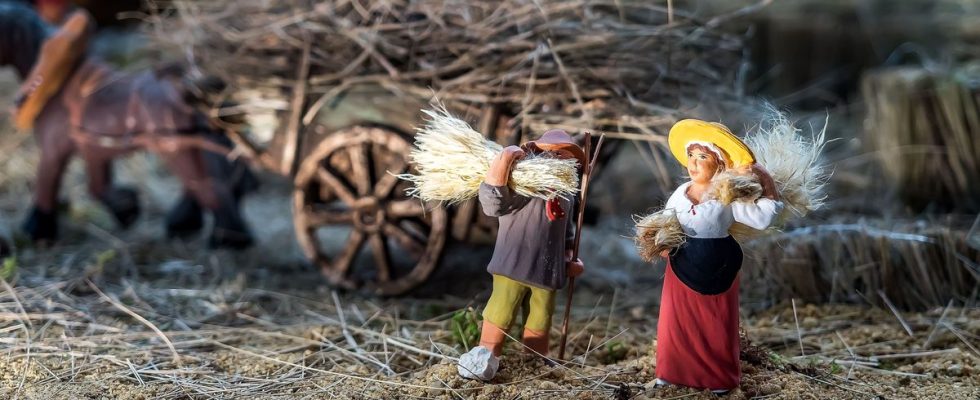Jesus, Mary, Joseph, a donkey, an ox and the three wise men, obviously. But not only. You can also see bowlers and card players, a schoolteacher, the village mayor, shepherds, fishermen, washerwomen, but also the unmissable “Lou Ravi”, which in Provençal designates a simple, simple-minded person. ‘spirit. All in a typical Provençal village landscape with its animals, its fields, its well, its fountains, its café, its town hall and its houses. In short, Provençal nativity scenes depict in miniature the life of a 19th century village, with its inhabitants all on their way to a stable which saw the birth of Jesus Christ. A Marcel Pagnol-style painting that we owe largely to another Marcel. Because if there is a ranking of the santonniers who made the history of the Provençal art of Christmas nativity scenes, Marcel Carbonel, born in 1911 and died in 2003, is at the top of the list.
“A businessman’s reflex”
“In the USA, we don’t say “a santon” but a “Carbonel””, illustrates Michel Bouvier, president of the Union of Santon Manufacturers of Provence. And it is his personal collection which is being sold at auction this Thursday in Marseille by the De Baecque house. This is made up of some 2,500 figurines, divided into 300 lots, with prices ranging from 50 to 3,000 euros. News that does not go down very well in the small world of santon makers which has 150 companies around Marseille, the overwhelming majority of which are family businesses which perpetuate from mother to son, from father to daughter, this know-how on the road to a UNESCO classification. This is especially true since the Carbonel company was bought three years ago by Serge Vitali, a Marseille businessman with no knowledge of the world of santon makers, who placed his two sons at the head of the company.
“What saddens me the most is that this collection will end up dispersed. I would have thought that a museum like the Mucem or the town hall would have negotiated its acquisition in advance,” continues Michel Bouvier, who knows what the santon makers owe to Marcel Carbonel. “He was the one who made the figurines take a 180° turn by focusing on refining their features, adding color to their clothes, making them beautiful. Finally, my grandfather said about him that he made figurines for Parisians,” he says.
His predecessor, the santon maker Arterra, says he is “not surprised” by this sale which he regrets. “For buyers, figurines are not a passion but a business. And it is logical that they do not value this collection on its heritage value but on its monetary value. It’s even a businessman’s reflex.”
The collection sold at auction was exhibited until 2020 in a small museum adjoining the workshops. This closed with Covid, and never reopened. Today, the Carbonel workshops, still located in the 7th arrondissement of Marseille, employ 35 full-time employees, not counting winter reinforcements, and produce around 2,000 figurines per week, 15 to 20% of which are shipped to foreign customers, from the USA, Switzerland but also, a new development, in the United Arab Emirates and as far as New Zealand. “We did offer the collection to the city of Marseille, which refused it,” assures Hanabelle Rocher, the workshop manager, who is a little reassuring about the future of this heritage. “But the most beautiful Carbonel pieces, like his nativity scene from 1961, the year he was voted best worker in France, remain with us,” she explains.
Santons from Provence, but also from Alaska, India and elsewhere
Because Marcel Carbonel had not only collected the figurines of his production. “Among the most beautiful lots in the sale, there is the complete nativity scene of Emilie Puccinelli-Meinier, crowned best worker in France in 1965,” presents Marie-Antoinette de Longcamps, communications manager for the De auction house. Baecque. But certain historical pieces, such as the church nativity scene by Marcel Carbonel, with human-sized figurines, are for sale. A sale which contains some astonishing pieces, reveals the communications manager: “There is a nativity scene made of bread crumbs, as they could be made in yesteryear. There is also a collection of figurines from Naples, and more surprisingly, pieces from countries in South America, India and even Alaska, where the ox is a bison. We thus realize the universal history of crèches, which goes far beyond Provence.
And if today the santon makers create new characters emblematic of the contemporary history of Marseille and Provence with, for example, figurines bearing the effigy by Bernard Tapieby Didier Raoult, or of OM playersnone of this new type will be present at this sale.

